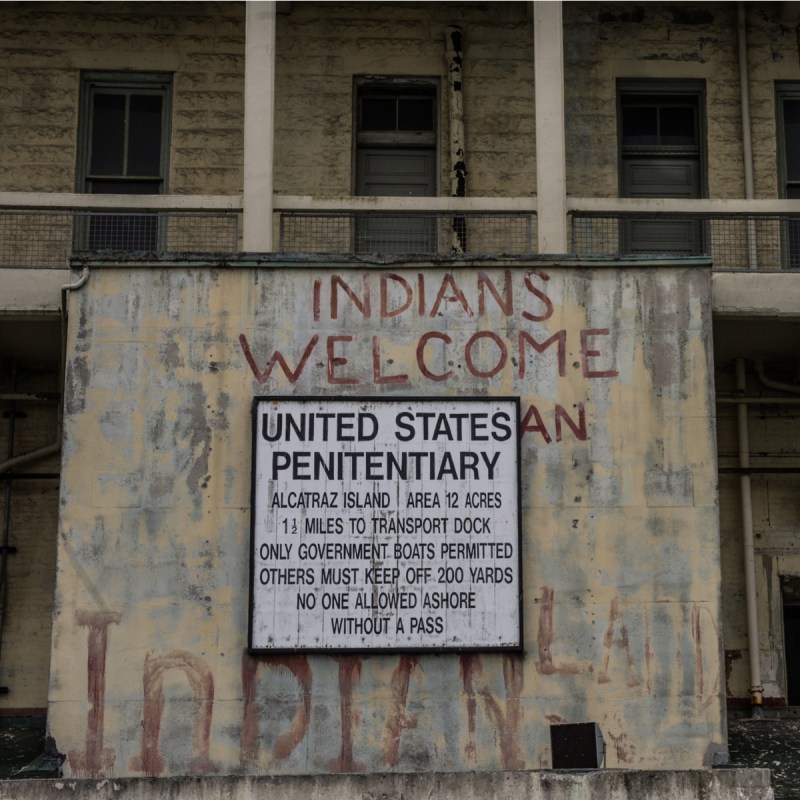
Built as a federal prison to house some of the country’s most notorious criminals, such as Al Capone and George “Machine Gun” Kelly, Alcatraz Island served as a lock-up from 1934 until its demise in 1963. Salt from the water in San Francisco Bay caused damage to the buildings on the island, so the federal government decided to close the once maximum-security prison. During its time, 36 men attempted to escape, but its location and the frigid water thwarted most, if not all, of them. Five men made it into the water, only to be listed as missing and presumed dead.
Videos by TravelAwaits
After its shutdown, Alcatraz would eventually reopen as a part of the National Park Service. Before that, history was made when in November 1969, a group of Native Americans took over the island and occupied it for about 19 months. Led by Richard Oakes, a citizen of the Mohawk nation, about 80 Native Americans initially occupied the island and were later joined by others, as they lived on the island until June 1971. During that time, the Indians of All Tribes (as they referred to themselves) built a community.
The National Park Service incorporates the story of the IAT during public tours of the island. From a sign welcoming all Indians to developing a functioning society, the occupation of Alcatraz has had a lasting impact on Native Americans for more than 50 years.
Here are five things to know about the Occupation of Alcatraz Island.

1. History Of The Occupation
Having outlived its usefulness to the federal government since opening as a military installation in 1850, Alcatraz Island lay dormant from 1963 until Oakes led the initial contingent of Native Americans there. Citing the Treaty of Laramie, an 1868 agreement that, among other things, ceded abandoned or surplus property back to Native Americans, Oakes and his followers seized the island.
The successful landing on November 20, 1969, followed earlier attempts to gain access, including a 1963 protest by Belva Cottier, a Sicangu Lakota (Rosebud Sioux) calling attention to the Laramie treaty. That occupation lasted 4 hours. Then, on November 9, 1969, 11 days before the successful settling of the island, a group of Native Americans, including Oakes, arranged for five boats to carry them to Alcatraz. However, none of the vessels showed up, so they convinced another person to take a few of them to the island on his yacht. Oakes and two others jumped off the boat as it neared Alcatraz. Their stint on the island was short, as the U.S. Coast Guard removed them. However, about a dozen more students from San Francisco State University sneaked onto the island later that day and spent the night before being hauled away by the Coast Guard.

2. Indians Of All Tribes
Since the Native Americans occupying Alcatraz Island came from all over North America and from different Native American nations, no one tribe was dominant, thus, no tribe name would be used to identify the new community. Indians of All Tribes described the group’s make-up. From Oakes’s Mohawk (Akwesasne) heritage to LaNada Means (War Jack) being Shoshone-Bannock, Indians of All Tribes described the group well.

3. Why Alcatraz Island?
For more than 10,000 years, long before European explorers found their way there, Alcatraz had been Indigenous land. As part of the territory occupied by the Ohlone people, San Francisco Bay was used for fishing and transportation. Alcatraz Island, while some historians believed the Ohlone thought it to be evil, was actually used for egg gathering, fishing, and hunting. It’s also thought that some ceremonies were held here.
While the Ohlone often considered visitors to their region as enemies, the tribe befriended early Spanish explorers who arrived in 1775.
In the early 1960s, the tribe was considered extinct by California anthropologists. But today, the Muwekma Ohlone consists of more than 500 members. Removed as a tribe under the Termination Act that lasted from the 1950s until 1969, the Ohlone have fought for federal and state government recognition for more than 20 years.
It was the Ohlone history that helped contribute to the occupation in 1969. Using “surplus” federal land, the Indians of All Tribes believed Alcatraz could develop into a cultural center for Native Americans across the land.

4. Life On The Island
While about 80 people originally occupied Alcatraz, once news spread, more people came to settle on the island. At its height, more than 400 Indigenous people lived on the island.
Leaders organized the occupation to operate as a community. Schools, health clinics, and other institutions were established. Each person on the island had a role, as a cook, security guard, and laundry worker. Supporters donated money and supplies, including a boat from the folk rock band Credence Clearwater Revival. Celebrities such as Anthony Quinn, Jane Fonda, and Dick Gregory would visit Alcatraz and publicly support the occupation.
Meanwhile, President Richard M. Nixon and his advisers sought a diplomatic solution to the occupation. He feared an armed invasion of the island would cause more issues than leaving the Native Americans alone. His plan to wait it out would eventually pay off.
As time passed, some of the people initially involved with the occupation returned to the mainland for school. Oakes, himself, left following the death of his young daughter after she fell down a staircase. The leader was shot to death in 1972 under suspicious circumstances.
As people left Alcatraz, some of their replacements weren’t as committed to the occupation. Drugs and alcohol were brought on to Alcatraz, and some people started challenging the leadership.
After more than a year and a half into the occupation and national attention dissipated, the Nixon administration sent federal agents to Alcatraz on June 11, 1971, to remove people. The occupation pretty much ended then, though a few hangers-on stayed for another year.

5. Legacy Of Alcatraz
While the Occupation of Alcatraz Island lasted only 19 months, its impact reverberates today. Considered the cornerstone of the Red Power movement, the occupation brought the plight of Native Americans into the living rooms of Americans during the evening news programs and in newspapers and magazines.
Politicians engaged the issues facing the nation’s First Peoples and passed legislation to improve life. Nixon has long been considered by many to be the most productive American president in addressing Native American issues, including the Self-Determination Act, which gave Native American tribes the right to create their own governments, schools, court systems, and more. It recognized that Native American tribes were their own sovereign nations.
The occupation is credited with renewing Native American pride. It led to future social justice endeavors including protests at colleges, federal buildings such as the Bureau of Indian Affairs, and the occupation of Wounded Knee in 1973, on the Pine Ridge reservation in South Dakota.
Future leaders grew from the Alcatraz experience. Wilma Mankiller was a young Cherokee woman working on the West Coast as the occupation unfolded. She joined the Indians of All Tribes and worked on Alcatraz. Mankiller would return to her home in Oklahoma and eventually serve as the first woman principal chief in tribal history.
Grace Thorpe, a Sac and Fox Nation citizen and daughter of sports legend Jim Thorpe, served as an advisor during Alcatraz Island. Afterward, she would serve as a lobbyist for the National Congress of American Indians, an organization founded in 1944, as well as co-founding the Native American Women’s Action Corps, which sought to empower Native American women and improve families. She was also an aide for a United States Senate subcommittee and worked as an attorney addressing environmental issues.
John Trudell (the author’s brother) served as the voice of Radio Free Alcatraz and later a spokesperson following Oakes’s departure from the island. Trudell went on to lead the American Indian Movement for about a decade following the Wounded Knee occupation. He later published poetry and became a successful spoken word musician and actor.
As for Alcatraz, itself, after the last members of the Occupation of Alcatraz Island departed, the former prison was turned over to the National Park Service. It opened as a national attraction in 1973. As part of the Golden Gate National Recreation Area, daily tours are offered, including the story of the occupation.
Pro Tips
Several tours of Alcatraz Island are offered throughout the day. For a unique experience, visit the island at night. Fog often moves in over the bay during the ferry ride to Alcatraz, adding a sense of drama to the tour. Touring the prison grounds at night, along with allegedly haunted cell blocks, can send a chill down your spine. With self-guided audio tours, Alcatraz Island comes alive during your visit, as you step inside cells once occupied by the worst criminals to walk the face of the Earth, patrol the cell blocks like a guard carrying a nightstick, and see where inmates spent their “free” time.
You’ll want to dress for cool conditions, as the temperature can change from the mainland to the island. Wear comfortable walking shoes, as you’ll traverse a lot of ground, some of it on uneven surfaces. Be sure to bring a camera, as you’ll want to take photographs of the prison, as well as the view of San Francisco from across the bay.
More interesting reading about Alcatraz and San Francisco:
